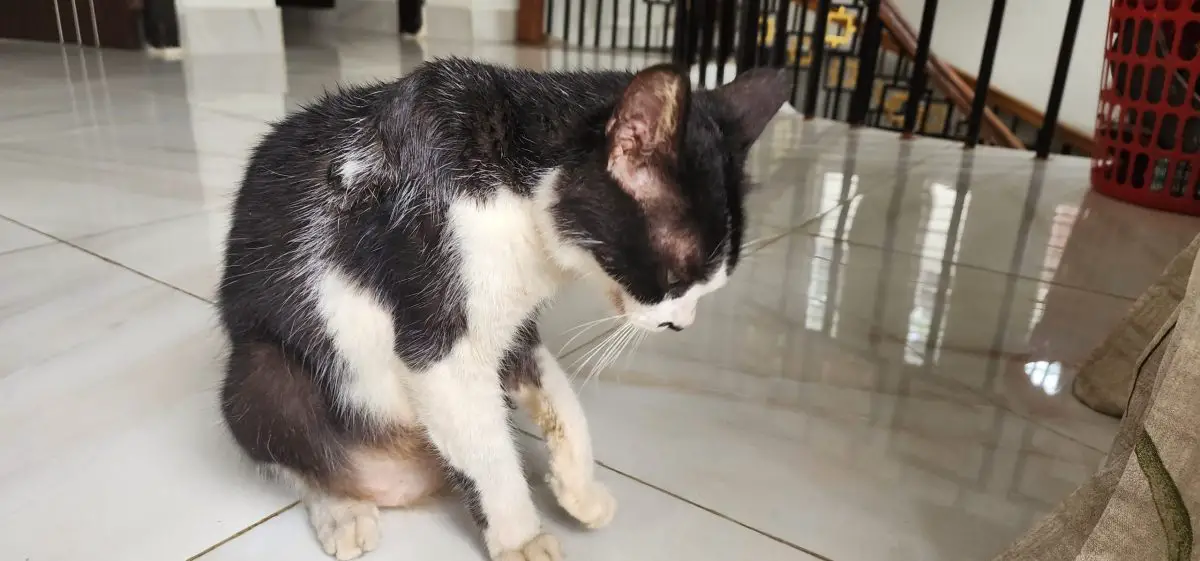Your pet cat can pee anywhere if not trained, which I have faced with my Muezza during its age under 5 months. So, if you want to make a surrendering cat for peeing in the house, here are the ways.
Start training your cat to pee in a litter box. Place a litter box in a good place with adequate and absorbable litter. Give your kitten food and after finishing keep it in the litter box. It will dig, pee, and then cover the excreta with litter. Practice this process with your kitten after every meal.
This article will give you information about potty training if you are a newbie with cats. If not, this article will still help you in many ways. Stay with this article!
Way Of Surrendering Cat For Peeing In The House
When my cat Muezza was a little kitten she used to pee anywhere in the house. But cats can be potty trained, so I also started training her at an early age.
At first, she was confused about what to do. But gradually she started peeing in a selected place. The process I followed is given below:
Step 1: Finding A Proper Place
A proper and fixed place is important for the kitten. It will be easy for the cat to go to the same place when needed. But if you change the place daily then it will be tough for it to excrete. It will find the litter box when needed.
If unable to find it then it can excrete any rough place in the house. It may also go outside and these things can hamper the training process.
Do not place the litter box beside her feeding place. Rather put it in a place free from noise and where it can get privacy.
Step 2: Preparing The Litter Box
Choosing a litter box is a difficult task. If your cat is only a few weeks old, then a big litter box will be oversized. It will be difficult for her to climb up. In the case of an adult cat, the litter box should be wide. Otherwise, it will not be comfortable in the litter box.
The size of the cat will increase gradually. So, if your cat is only a few weeks old then buy a small litter box. But if it is an adult then buying a large size will be the best option. But to cut extra expenses, you can buy only the large one. In that case you should place your few week old cat every time it is excreting. Help your cat to reach the litter box until it can climb its own. Find out one thing, if your cat needs privacy.
If it is shy to use the litter box in front of you then give it a covered litter box. Covered or uncovered litter box, choose the best one for your cat based on its preference.
Step 3: Choosing A Good Litter
Cats are choosy about the litter. They will never urinate until they find the litter is comfortable. While giving litter, make sure the litter is dust-free. Dust in the litter can cause respiratory illnesses in cats.
The liter should absorb well. You can find a variety of litter in the market. But among all, the clumping litter is the best. You may have an outsider cat who is used to sand and dust. In that case, for a few days, train with sand. Then gradually replace it with litter.
Step 4: Placing Her In the Litter Box
If your cat is previously trained by a breeder or previous owner then it will be easy to train. Give her the proper amount of food and then take her to the litter box. Place her above the litter. It will start digging into the litter and hide the urine with litter after urination.
But if it is a kitten and not trained then follow the same process after every meal. If it is not digging then help her. Show her how to dig with your finger. The kitten will follow you after a few tries. It will be easier if you have a trained cat. The little one will learn by seeing the outer cat doing the process.
Step 5: Remove The Waste
The final task is to remove the excreta. Cats do not like scanty or dirty litter. So try to keep the litter clean. Remove the excreta after every excretion.
Hold the litter box on one side. The litter will go to that side. But the absorbed litter will remain in the same place. Now just remove the absorbed litter with the help of a litter scooper.
This is how you can train her to pee in the house. If you train your cat well, it will never go outside for peeing. Rather the cat will be comfortable using the litter box.
Why Does The Cat Not Like Peeing In A Litter Box?
If the cat becomes accustomed to the litter box, it will not be excreted in other places. But despite trying a lot of time, you may notice that your pet is peeing and pooping in other places. If this is happening then there must be a problem in the litter box.
The reasons behind cats not peeing in a litter box could be as follows:
- The litter box is not so wide or comfortable.
- Cats do not like litter.
- The litter is not clean.
- The litter box is not placed in a good place.
- The litter is smelling.
- The cat is under stress.
- It is suffering from health problems.
Try with another litter box or litter. Also, clean the litter regularly. If your cat is suffering from any health condition, consult a vet immediately.
What Is The Best Time For Peeing A Cat?
In the case of a trained kitten, it will excrete anytime if it feels pressure. There is no best time for peeing or pooping.
But to train a kitten after a meal is the best time. Because they remain full at that time and it is easy to teach them at that time. As a house cat, always keep an eye on how many times they excrete. Feline lower urinary tract disease is a common disease due to obstruction in the urinary tract. If they are not urinating for a long time then it could be the possible cause.
FAQs
These are some commonly asked questions by people about the peeing process of cats.
How Many Times Should A Cat Pee?
A cat should pee at least two times a day. Two to four times a day is an average schedule for an indoor cat. The frequency may increase or decrease with many factors like intake of water and age.
Should you punish your cat for peeing in the house?
You should never punish your cat for peeing in the house. You should not even yell at them. Doing these can make your cat stressed. Also, it can hamper the bonding between you and your pet.
Can you rub a cat’s nose while it is peeing?
You should not rub a cat’s nose while it is peeing. It will disturb the excretion process. Also, the cat may not complete urination. Incomplete urination can cause various diseases.
Conclusion
Cats can pee anywhere in the house or outside. Fortunately, it is easy to train a cat to pee in a fixed place. Training for a few days can change this habit of a pet cat. The process is also easy. Train the cat two to three times a day.
Cats easily learn the process. If the cat is comfortable with the litter box, location, and the litter then it will pee there. Daily clean the litter. Be careful whether the litter is smell-free. Give your cat privacy while peeing. Take care of your cat and stay safe!


Leave a Reply